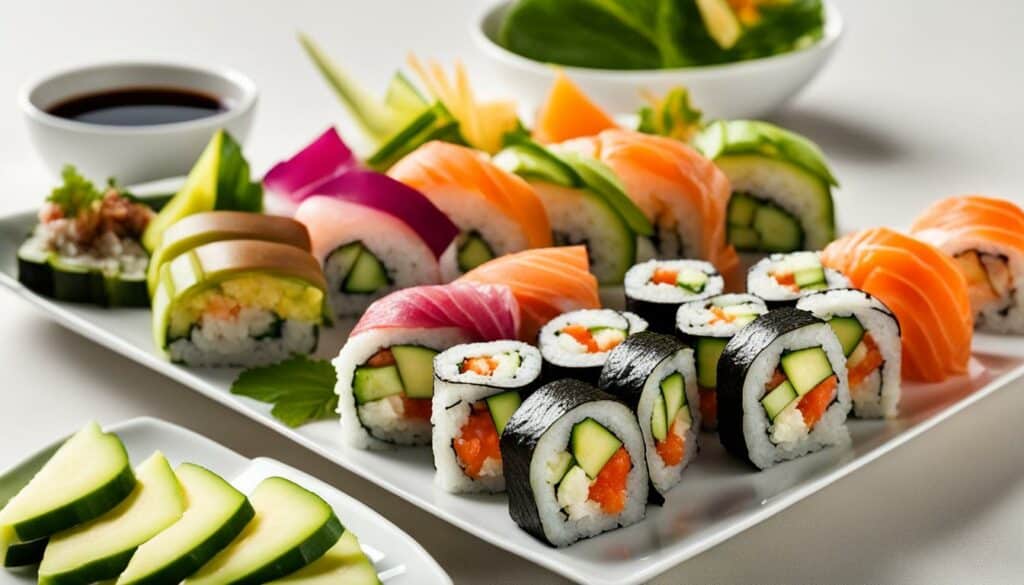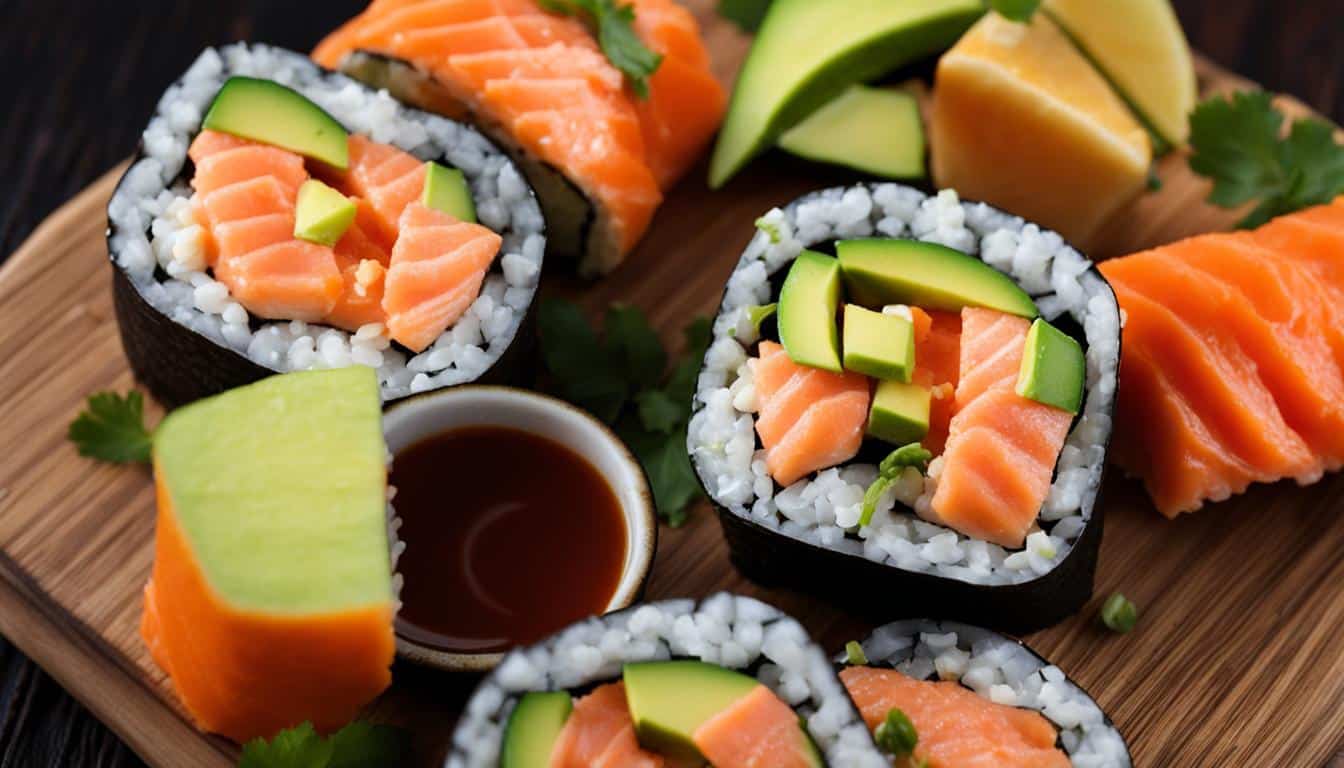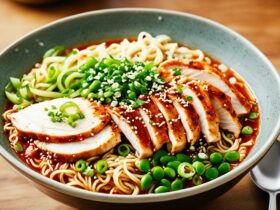Are you wondering how many calories are in a spicy salmon roll? Look no further, as we reveal the truth about this popular sushi roll! Whether you’re watching your calorie intake or simply curious about the nutritional value, it’s essential to know what you’re consuming.
The spicy salmon roll is a delectable combination of fresh salmon, rice, and a touch of heat from spicy mayo or other seasonings. But just how many calories does it contain? Let’s dive into the nutrition facts and uncover the truth!
Key Takeaways:
- A spicy salmon roll typically contains 190 calories per 100 grams.
- It provides 6 grams of protein, 24 grams of carbs, 6 grams of fat, and 330 mg of sodium.
- Salmon, a key ingredient in the roll, is rich in omega-3 fatty acids that support heart health.
- The spicy salmon roll offers a delicious way to enjoy sushi while reaping health benefits.
- Consider moderation and dietary goals when enjoying sushi rolls.
The Health Benefits of Spicy Salmon Roll
The spicy salmon roll offers several health benefits. It is made with salmon, which is a rich source of omega-3 fatty acids. These fatty acids have been shown to reduce inflammation, improve heart health, and support brain function. Omega-3 fatty acids are essential for a healthy diet and are not produced by the body, so consuming them through foods like salmon is important.
In addition to omega-3 fatty acids, spicy salmon rolls also provide other nutritional benefits. The roll contains rice, which provides energy and is a good source of carbohydrates. Nori, the seaweed wrapper used in sushi rolls, is rich in vitamins and minerals such as iodine, vitamin A, vitamin C, and calcium. Nori also adds a unique flavor and texture to the roll.
The combination of salmon, rice, and nori in a spicy salmon roll makes it a well-rounded meal. It offers a balance of protein, carbohydrates, and healthy fats, making it a satisfying and nutritious choice. Incorporating spicy salmon rolls into your diet can contribute to a healthy, balanced eating plan.
| Nutrient | Amount per 100g |
|---|---|
| Calories | 190 |
| Protein | 6g |
| Carbohydrates | 24g |
| Fat | 6g |
| Sodium | 330mg |
Calories in Other Popular Sushi Rolls
While the spicy salmon roll is a popular choice, it’s important to explore the calorie content of other sushi rolls as well. Here’s a breakdown of the calorie counts for some popular options:
| Sushi Roll | Calories |
|---|---|
| California Roll | 93 |
| Spicy Tuna Roll | 175 |
| Shrimp Tempura Roll | 175 |
| Avocado Roll | 140 |
| Rainbow Roll | 146 |
| Philadelphia Roll | 170 |
| Salmon Avocado Roll | 179 |
These calorie counts are based on two to three pieces of each roll. It’s important to note that the calorie content may vary slightly depending on the specific ingredients and preparation methods. However, this gives you a general idea of the calorie range for these popular sushi rolls.
When choosing sushi, it’s helpful to be aware of the calorie content so you can make informed decisions based on your dietary needs and goals. If you’re looking for lower-calorie options, the California roll and avocado roll are good choices. If you prefer something with a bit more flavor, the spicy tuna roll and salmon avocado roll are still reasonable in terms of calorie content.
Remember, moderation is key. Enjoying sushi as part of a balanced diet can be a delicious and nutritious way to satisfy your cravings for Japanese cuisine while maintaining a healthy lifestyle.
Tips for Making Sushi Healthier
If you’re looking to enjoy sushi while maintaining a healthy diet, there are several tips you can follow to make your sushi experience healthier and lower in calories. By making a few smart choices, you can still indulge in this delicious Japanese cuisine without compromising your nutritional goals.
Choose Rolls with Alternative Grains
One way to make sushi healthier is by opting for rolls made with alternative grains like brown rice or quinoa. These grains are higher in fiber and provide added nutritional benefits compared to traditional white rice. The extra fiber will help keep you feeling full for longer and can aid in digestion.
Explore Rice-Free Options
If you’re looking for a low-calorie sushi choice, consider exploring rice-free options like sashimi. Sashimi consists of thinly sliced raw fish and is typically served without rice. This option can be an excellent source of lean protein with fewer calories and carbs compared to sushi rolls. It allows you to enjoy the flavors of the fish without the extra calories from rice.
Use Soy Sauce Sparingly
While soy sauce adds flavor to sushi, it can be high in sodium. To reduce your sodium intake, request soy sauce on the side and use it sparingly. By dipping your sushi lightly, you can still enjoy the taste without consuming excessive amounts of sodium.
Choose Low-Fat Ingredients
When selecting sushi rolls, opt for those with low-fat ingredients. Avoid rolls that contain fried items or mayonnaise-based sauces, as these can add unnecessary calories and unhealthy fats. Instead, choose rolls filled with fresh vegetables, lean proteins, and heart-healthy ingredients like avocado.
By following these tips, you can make sushi a healthier choice in your diet. Remember to enjoy sushi in moderation, and consider incorporating other side dishes like miso soup and edamame for added nutrients. With these simple modifications, you can savor the flavors of sushi while maintaining a balanced and nutritious eating plan.
| Sushi Roll | Calories |
|---|---|
| Avocado Roll | 140 |
| Tuna Roll | 184 |
| Philadelphia Roll | 255 |
| Spicy Tuna Roll | 290 |
| Salmon Avocado Roll | 304 |
| Spider Roll | 317 |
| Caterpillar Roll | 390 |
| Eel Avocado Roll | 372 |
| Rainbow Roll | 475 |
| Shrimp Tempura Roll | 508 |
The Role of Sashimi and Nigiri in a Sushi Meal
When it comes to sushi, there are a wide variety of options to choose from. Two popular choices are sashimi and nigiri. Sashimi consists of thinly sliced raw fish, often served without rice. Nigiri, on the other hand, features a thin slice of raw fish placed on top of a small bed of rice. Both sashimi and nigiri have their own unique characteristics and are enjoyed by sushi enthusiasts worldwide.
Sashimi is a great option for those who are watching their calorie and carbohydrate intake. As it does not include rice, sashimi tends to be lower in calories and carbs compared to other types of sushi. For example, a serving of salmon sashimi contains approximately 127 calories, while tuna nigiri contains around 117 calories.
On the other hand, nigiri offers a balanced combination of flavors and textures. The rice provides a neutral base that complements the flavors of the raw fish. It also offers a satisfying mouthfeel that many sushi lovers enjoy. While nigiri does contain rice, the portion size is typically smaller compared to sushi rolls, resulting in a lower calorie count.
The Nutritional Facts of Sashimi and Nigiri
For a clearer picture of the nutritional content of sashimi and nigiri, let’s take a look at the table below:

As shown in the table, both sashimi and nigiri are relatively low in calories compared to sushi rolls. They are also excellent sources of protein, providing essential amino acids for muscle growth and repair. Additionally, sashimi and nigiri are rich in omega-3 fatty acids, which have been shown to have numerous health benefits, including reducing inflammation and supporting heart health.
When enjoying sushi, it’s important to consider your own dietary preferences and goals. Whether you prefer the simplicity of sashimi or the balanced flavors of nigiri, both options offer a delicious and nutritious way to enjoy raw fish in a sushi meal.
Ranking Sushi Rolls by Calorie Content
When it comes to enjoying sushi, it’s important to be mindful of the calorie content, especially if you’re watching your calorie intake or trying to make healthier choices. To help you navigate the world of sushi, here is a ranking of sushi rolls based on their calorie content, from lowest to highest:
| Sushi Roll | Calories |
|---|---|
| Avocado roll | 140 |
| Tuna roll | 184 |
| Philadelphia roll | 255 |
| Spicy tuna roll | 290 |
| Salmon avocado roll | 304 |
| Spider roll | 317 |
| Caterpillar roll | 390 |
| Eel avocado roll | 372 |
| Rainbow roll | 475 |
| Shrimp tempura roll | 508 |
Please note that these calorie counts are approximate and can vary depending on the specific ingredients and preparation methods used by different sushi restaurants. It’s always a good idea to check with the restaurant for the most accurate calorie information.
As you can see from the ranking above, the avocado roll is a great low-calorie option, with only 140 calories. Tuna and Philadelphia rolls also provide relatively lower calorie options compared to other rolls. On the other hand, shrimp tempura and rainbow rolls have higher calorie content, making them best enjoyed in moderation.
Remember that while calorie content is important, it’s also essential to consider other factors like nutritional value, portion sizes, and your overall dietary goals when making sushi choices. Don’t be afraid to explore different types of sushi rolls and find the ones that suit your taste preferences and health needs.

Conclusion
In conclusion, the calorie content of sushi rolls can vary significantly depending on the ingredients and preparation methods. For those concerned about calorie intake, a spicy salmon roll typically contains 190 calories. However, there are healthier options available.
To enjoy sushi without compromising on nutrition, consider choosing rolls made with alternative grains like brown rice or quinoa for added fiber and nutrition. Rice-free options like sashimi are also a great low-calorie choice. Remember to use soy sauce sparingly to reduce sodium intake. Additionally, focus on the side dishes like miso soup and edamame for added nutrients.
While sushi can be a delicious and nutritious choice, it’s always important to consider your overall dietary goals and preferences. Enjoy sushi in moderation and make informed choices based on your own needs. By following these tips and selecting healthier options, you can still indulge in sushi while maintaining a balanced diet.
FAQ
How many calories does a spicy salmon roll contain?
A spicy salmon roll typically contains 190 calories per 100 grams.
What are the health benefits of a spicy salmon roll?
The spicy salmon roll offers health benefits from the salmon, which is rich in omega-3 fatty acids that support heart health.
How many calories do other popular sushi rolls contain?
Other popular sushi rolls have varying calorie counts. For example, the California roll contains 93 calories, the spicy tuna roll contains 175 calories, the shrimp tempura roll contains 175 calories, the avocado roll contains 140 calories, the rainbow roll contains 146 calories, the Philadelphia roll contains 170 calories, and the salmon avocado roll contains 179 calories (based on two to three pieces of each roll).
How can I make my sushi experience healthier?
To make your sushi experience healthier, you can choose rolls made with alternative grains like brown rice or quinoa, opt for rice-free options like sashimi, get soy sauce on the side and use it sparingly, choose rolls with low-fat ingredients, and focus on side dishes like miso soup and edamame for added nutrients.
What is the difference between sashimi and nigiri?
Sashimi is a rice-free sushi option that consists of thinly sliced raw fish, while nigiri is a type of sushi that features a thin slice of raw fish on top of a small bed of rice.
How many calories do sashimi and nigiri contain?
Sashimi is generally lower in calories and carbs than most other types of sushi. For example, salmon sashimi contains 127 calories, while tuna nigiri contains 117 calories.
How do sushi rolls rank in terms of calorie content?
Sushi rolls can vary in calorie content. Popular sushi rolls ranked by calorie content from lowest to highest include: avocado roll, tuna roll, Philadelphia roll, spicy tuna roll, salmon avocado roll, spider roll, caterpillar roll, eel avocado roll, rainbow roll, and shrimp tempura roll. Please note that these calorie counts are approximate and may vary.















FIND US ON SOCIALS